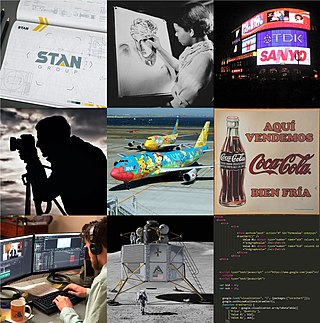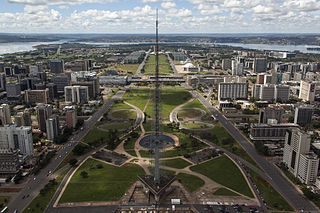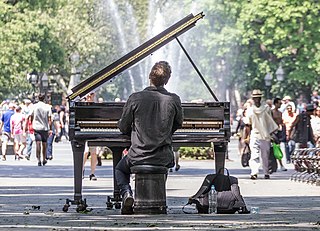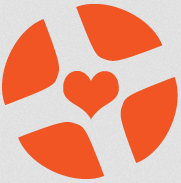
Graphic design is a profession, academic discipline and applied art whose activity consists in projecting visual communications intended to transmit specific messages to social groups, with specific objectives. Graphic design is an interdisciplinary branch of design and of the fine arts. Its practice involves creativity, innovation and lateral thinking using manual or digital tools, where it is usual to use text and graphics to communicate visually.

Urban design is an approach to the design of buildings and the spaces between them that focuses on specific design processes and outcomes. In addition to designing and shaping the physical features of towns, cities, and regional spaces, urban design considers 'bigger picture' issues of economic, social and environmental value and social design. The scope of a project can range from a local street or public space to an entire city and surrounding areas. Urban designers connect the fields of architecture, landscape architecture and urban planning to better organize physical space and community environments.

In criminology, the broken windows theory states that visible signs of crime, antisocial behavior, and civil disorder create an urban environment that encourages further crime and disorder, including serious crimes. The theory suggests that policing methods that target minor crimes such as vandalism, loitering, public drinking, jaywalking, and fare evasion help to create an atmosphere of order and lawfulness.

A public space is a place that is open and accessible to the general public. Roads, public squares, parks, and beaches are typically considered public space. To a limited extent, government buildings which are open to the public, such as public libraries, are public spaces, although they tend to have restricted areas and greater limits upon use. Although not considered public space, privately owned buildings or property visible from sidewalks and public thoroughfares may affect the public visual landscape, for example, by outdoor advertising. Recently, the concept of shared space has been advanced to enhance the experience of pedestrians in public space jointly used by automobiles and other vehicles.
Topcoder is a crowdsourcing company with an open global community of designers, developers, data scientists, and competitive programmers. Topcoder pays community members for their work on the projects and sells community services to corporate, mid-size, and small-business clients. Topcoder also organizes the annual Topcoder Open tournament and a series of smaller regional events.
Participatory design is an approach to design attempting to actively involve all stakeholders in the design process to help ensure the result meets their needs and is usable. Participatory design is an approach which is focused on processes and procedures of design and is not a design style. The term is used in a variety of fields e.g. software design, urban design, architecture, landscape architecture, product design, sustainability, graphic design, planning, and health services development as a way of creating environments that are more responsive and appropriate to their inhabitants' and users' cultural, emotional, spiritual and practical needs. It is also one approach to placemaking.

Renovation is the process of improving broken, damaged, or outdated structures. Renovations are typically done on either commercial or residential buildings. Additionally, renovation can refer to making something new, or bringing something back to life and can apply in social contexts. For example, a community can be renovated if it is strengthened and revived. It can also be restoring something to a former better state.
The commons is the cultural and natural resources accessible to all members of a society, including natural materials such as air, water, and a habitable Earth. These resources are held in common even when owned privately or publicly. Commons can also be understood as natural resources that groups of people manage for individual and collective benefit. Characteristically, this involves a variety of informal norms and values employed for a governance mechanism. Commons can also be defined as a social practice of governing a resource not by state or market but by a community of users that self-governs the resource through institutions that it creates.

Placemaking is a multi-faceted approach to the planning, design and management of public spaces. Placemaking capitalizes on a local community's assets, inspiration, and potential, with the intention of creating public spaces that improve urban vitality and promote people's health, happiness, and well-being. It is political due to the nature of place identity. Placemaking is both a process and a philosophy that makes use of urban design principles. It can be either official and government led, or community driven grassroots tactical urbanism, such as extending sidewalks with chalk, paint, and planters, or open streets events such as Bogotá, Colombia's Ciclovía. Good placemaking makes use of underutilized space to enhance the urban experience at the pedestrian scale to build habits of locals.
Project for Public Spaces (PPS) is a nonprofit organization based in New York dedicated to creating and sustaining public places that build communities, in an effort often termed placemaking.

Crowdsourcing involves a large group of dispersed participants contributing or producing goods or services—including ideas, votes, micro-tasks, and finances—for payment or as volunteers. Contemporary crowdsourcing often involves digital platforms to attract and divide work between participants to achieve a cumulative result. Crowdsourcing is not limited to online activity, however, and there are various historical examples of crowdsourcing. The word crowdsourcing is a portmanteau of "crowd" and "outsourcing". In contrast to outsourcing, crowdsourcing usually involves less specific and more public groups of participants.
Principles of intelligent urbanism (PIU) is a theory of urban planning composed of a set of ten axioms intended to guide the formulation of city plans and urban designs. They are intended to reconcile and integrate diverse urban planning and management concerns. These axioms include environmental sustainability, heritage conservation, appropriate technology, infrastructure-efficiency, placemaking, social access, transit-oriented development, regional integration, human scale, and institutional integrity. The term was coined by Prof. Christopher Charles Benninger.
Place identity or place-based identity refers to a cluster of ideas about place and identity in the fields of geography, urban planning, urban design, landscape architecture, interior design, spatial design, environmental psychology, ecocriticism and urban sociology/ecological sociology. Place identity is sometimes called urban character, neighbourhood character or local character. Place identity has become a significant issue in the last 25 years in urban planning and design. Place identity concerns the meaning and significance of places for their inhabitants and users, and how these meanings contribute to individuals' conceptualizations of self. Place identity also relates to the context of modernity, history and the politics of representation. In other words, historical determinism, which intersects historical events, social spaces and groups by gender, class, ethnicity. In this way, it explores how spaces have evolved over time by exploring the social constructs through time and the development of space, place and power. To the same extent, the politics of representation is brought into context, as the making of place identity in a community also relates to the exclusion or inclusion in a community. Through this, some have argued that place identity has become an area for social change because it gives marginalized communities agency over their own spaces. In the same respect, it is argued that place identity has also been used to intervene social change and perpetuate oppression from a top-down approach by creating segregated spaces for marginalized communities.

In urban planning, walkability is the accessibility of amenities by foot. It is based on the idea that urban spaces should be more than just transport corridors designed for maximum vehicle throughput. Instead, it should be relatively complete livable spaces that serve a variety of uses, users, and transportation modes and reduce the need for cars for travel.

The City Repair Project is a 501(c)(3) non-profit organization based in Portland, Oregon. Its focus is education and activism for community building. The organizational motto is "The City Repair Project is group of citizen activists creating public gathering places and helping others to creatively transform the places where they live."

A hackerspace is a community-operated, often "not for profit", workspace where people with common interests, such as computers, machining, technology, science, digital art, or electronic art, can meet, socialize, and collaborate. Hackerspaces are comparable to other community-operated spaces with similar aims and mechanisms such as Fab Lab, men's sheds, and commercial "for-profit" companies.

Social collaboration refers to processes that help multiple people or groups interact and share information to achieve common goals. Such processes find their 'natural' environment on the Internet, where collaboration and social dissemination of information are made easier by current innovations and the proliferation of the web.
Public Achievement is an "initiative" of the Center for Democracy and Citizenship at Augsburg University. It involves young people working in teams on a public works project of their choice. An adult coach, typically a teacher or university student trained in the process and concepts of Public Achievement, guides team members through the following stages: exploration and discovery; issue selection and development; problem research; designing a project; implementing the action plan and making the work visible; and celebrating. Throughout the process, the coach holds team members accountable, and creates space for reflection and opportunities for each team member to practice and refine their civic skills. The coach makes overt connections between the group’s work and civic and political concepts. Ideally, an experienced PA site coordinator provides mentoring and assists PA coaches in reflecting on their own learning.
Citizen sourcing is the government adoption of crowdsourcing techniques for the purposes of (1) enlisting citizens in the design and execution of government services and (2) tapping into the citizenry's collective intelligence for solutions and situational awareness. Applications of citizen sourcing include:










